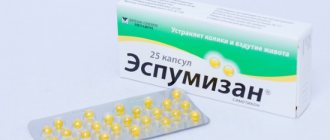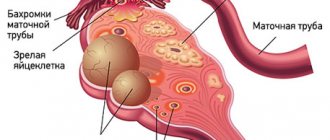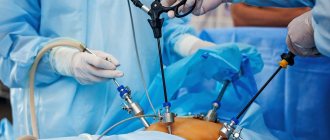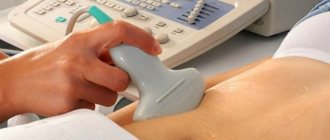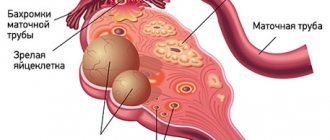Any operation is a big stress for the body. Even after minimally invasive laparoscopy, complications can develop. During the rehabilitation period after ovarian surgery, many women experience problems with stool: feces become dry and hard, are difficult to pass, fill the intestines and put pressure on nearby organs. This negatively affects recovery, causes severe discomfort and worsens well-being. Let's consider what the delicate problem is associated with and how to get rid of constipation after ovarian laparoscopy.
Make an appointment
Anal fissure surgery is performed in cases where other treatment methods have failed. Of course, any surgical intervention causes anxiety among those undergoing surgery. They think that the main thing is that the operation goes well, and then there is nothing to worry about. This is fundamentally wrong. The first days and even weeks after surgery for anal fissure are of great importance. Firstly, because the patient experiences quite significant discomfort. And secondly, the postoperative period after any surgical intervention determines the long-term prognosis of the patient’s health.
Treatment of constipation after surgery
Restoring the function of the digestive system after abdominal surgery is aimed at solving several problems:
- normalization of intestinal motility;
- improvement of the condition and function of the mucous membranes of the stomach;
- prevention and treatment of dysbiosis associated with antibacterial therapy;
- prevention of postoperative complications;
- improving the patient's well-being.
Symptoms of constipation include stool retention for 1–2 days, bloating, increased gas formation, false urge to defecate, a feeling of fullness in the rectum, and abdominal pain. If you have regular bowel movements, constipation can be indicated by the dense consistency of stool, a feeling of incomplete bowel movement, as well as the need for strong straining during bowel movements.

The doctor will definitely tell you how to improve your bowel movements after surgery. This applies not only to patients who have undergone intestinal interventions, but also to people operated on for diseases of the pelvic organs. There are several methods for restoring bowel movements:
- Medication. The doctor will prescribe digestive enzymes, probiotics, and drugs to improve intestinal motility. It is advisable to resort to painkillers; they will help you better endure the early postoperative period. Complex treatment will help restore normal functions of the gastrointestinal tract, ensure better absorption of nutrients from food, as well as the removal of waste products. It is important to remember that this is a temporary measure to support the body weakened by the operation. If the problem returns after completing the course of therapy, you need to consult a specialist again.
- Dietary. After surgery, a special diet is required, which allows you to gradually activate the digestive system and prevent complications and constipation. As a rule, in a hospital a special table is organized for each patient. The principles of nutrition are frequent, fractional meals. The basis of the diet is cereal porridge with water, fish, steamed meat and poultry, and vegetables. In the first few days, depending on the type of operation, it may be recommended to consume only broths and pureed food. It is important to strictly follow the doctor’s instructions and avoid flour products, fatty, fried foods, marinades, sweets, coffee and strong tea.
The specialist will also suggest the optimal drinking regime. Much is determined by the specifics of the operation, but general recommendations include taking a sufficient volume of clean drinking water - up to 1.5–2 liters.
The volume of liquid consumed includes vegetable and meat broths and soups. The liquid will help maintain the normal consistency of stool, cope with intoxication and recover faster after surgery. A glass of water drunk in the morning on an empty stomach will trigger intestinal peristalsis and provoke the necessary reflexes.

- Herbal health. Herbal laxatives can help restore normal bowel function after surgery. Take medications with a mild effect to eliminate pain and spasms. In the postoperative period, it is important to exclude diarrhea, so it is better to use laxatives, which act delicately and help soften the stool and make it more comfortable for elimination.
One of these drugs is Fitomucil Norm. The composition of the English remedy includes the pulp of the fruits of domestic plums, as well as the shell of the seeds of the plantain Plantago Psyllium. The drug does not contain senna, is not addictive, acts gently and helps normalize stool.
Prebiotics play a special role in constipation after surgery. These food components are not digested or absorbed in the upper parts of the digestive system. But they are fermented by the microflora of the large intestine and serve as favorable soil for the colonization of beneficial bacteria. Prebiotics will help cope with dysbiosis, improve the state of microflora, and therefore effectively influence one of the mechanisms of constipation development - disturbance of the intestinal microbial balance.
In combination with probiotic bacteria - bifidobacteria and lactobacilli - this method of restoring intestinal function will give quick results. This is especially true in cases of antibacterial therapy and high risks of developing dysbacteriosis.
You can cope with constipation after intestinal surgery using an integrated approach. It is necessary to follow recommendations regarding physical activity - the attending physician will tell you when you can get up and walk. It is important to adhere to the recommended diet, take probiotics prescribed by your doctor to prevent dysbiosis and related disorders, and also not to restrain the urge to defecate. This will help improve bowel function faster.
How to care for the postoperative field
- Already on the second day after the operation, you can remove the bandage from the wound and take the first hot bath.
- After a bath or shower, the operated area should be thoroughly dried. At first it is better to do this with a hairdryer.
- After each bowel movement, carefully clean the anus with soft toilet paper, or even better, wash it with warm water.
- If the doctor warned the person undergoing surgery that a damp cloth should be kept on the wound for several days, changing it from time to time, then you should not neglect the doctor’s words.
Urination
It happens that immediately after surgery there are difficulties urinating. When some tension is needed in order to go down a small one, this is not a problem, since it will not damage the operated area. If urination still does not occur, then you can help yourself this way - sit in a warm bath and try to urinate there. However, in the case where, despite all efforts, the bladder has not been released 12 hours after the operation, the doctor should be notified. The doctor will take all measures and, if necessary, insert a catheter.
What can you do
You can do anything that does not cause discomfort. But you should remember:
- It is best to avoid driving while painkillers are taken.
- You can return to work when you are sure that this will not become a problem. You should not rush to work in the first days after surgery. It is better to wait a while until the body finally gets stronger.
In general, any operation is stressful. Therefore, even when the postoperative period passes without incident, after a certain period of time it is necessary to see a doctor. Doctors at our clinic never leave an operated patient without attention. All patients, no matter how well their postoperative period proceeds, are thoroughly examined a month after the surgical procedure. They are given a full report on the condition of the postoperative wound, and are given recommendations on the topic “how to live so as to never suffer from an anal fissure again.”
On the first day after surgery, you will most likely need to take painkillers every three to four hours. The pain may last up to two weeks.
Condition after cholecystectomy: a gastroenterologist's view
Yu.A. CURLY
,
State Budgetary Educational Institution of Higher Professional Education "Moscow State Medical and Dental University named after. A.I. Evdokimov” of the Russian Ministry of Health Cholecystectomy is one of the most frequently performed surgical interventions in Russia and the world. Complaints of pain and dyspepsia occur in at least half of the patients who have undergone such an operation. Postcholecystectomy syndrome (PCES) is a polyetiological syndrome, which may be behind functional and organic causes. About half of the cases of pain and dyspepsia after cholecystectomy are associated with organic diseases (stricture of the distal common bile duct, cancer of the pancreas and stomach, acute pancreatitis, etc.). The remaining cases are due to functional causes, including dysfunction of the sphincter of Oddi and functional disorders of intestinal motility. Introduction
Gallstone disease (GSD) over the past few decades has become one of the most common organic human diseases (10–15% in the adult population), for which a large number of planned and emergency surgical interventions are performed throughout the world [30]. In the United States alone, about 1 million new cases of cholelithiasis are detected annually; the cost of treating this disease exceeds $6 billion per year [10]. In Russia, about 200 thousand cholecystectomies are performed annually, mainly laparoscopically [1].
It is well known that only 20% of patients with cholelithiasis present with symptoms [33]. In the case of symptomatic cholelithiasis, surgical intervention helps relieve symptoms in 53.0–81.5% of cases [20, 29], reduce the severity of dyspepsia and biliary pain – in 56 and 72% of cases, respectively [6]. Unfortunately, a considerable number of patients (40.4%) do not report relief after cholecystectomy [22]. Based on the results of large studies, we can conclude that the symptoms of pain and dyspepsia after cholecystectomy persist with a large variability in frequency (from 5.6 to 57.3%) [15, 23, 26, 37, 38]. This variation in the frequency of persistence of postcholecystectomy complaints mainly depends on the study design. What is interesting, especially in terms of the frequent asymptomatic course of cholelithiasis, quite often complaints from the gastrointestinal tract appear for the first time only after surgical treatment of cholelithiasis (12.0-38.6%) [15, 23, 26, 37, 38]. Thus, up to half of the patients who underwent cholecystectomy, at different times from the moment of the operation, demonstrate complaints of abdominal pain and symptoms of gastric and intestinal dyspepsia, explained by both organic and functional causes [10].
Definition of postcholecystectomy syndrome (PCES). “PHES” is only a seemingly simple problem; the difficulties of understanding the syndrome begin with the definition itself. The first works, one way or another describing the pathological conditions in patients after cholecystectomy, appeared abroad quite a long time ago - in the late 1930s. [13, 18, 26]. The most significant is the first series of observations presented by J. Hellstrom in 1938, which was based on data from KK Nygaard and included 141 patients. Thus, 30% of the patients included in the series of observations after removal of the gallbladder had spastic-type abdominal pain, similar to what they had before surgery. Only 9 patients were diagnosed with choledocholithiasis, and even less often acute pancreatitis was diagnosed. The authors were unable to explain the causes of pain in other cases, and the author called the identified pain “postcholecystectomy colic” [18]. The next largest series of observations was presented by H. Doubilet only as an oral report at a meeting of the Surgical Section of the New York Academy of Medicine in April 1943 [11], which was presented in detail in a subsequent review by R. Colp [9]. The series consisted of 253 patients who underwent cholecystectomy and were observed for a period of 1 to 7 years.
The author reports that 40% of the observed patients were characterized by postoperative symptoms, often similar to the symptoms before surgery. It is in these two works [9, 11] that the term “PCES” is first used, explaining a complex of various disorders after cholecystectomy, most of which, due to the absence of organic causes (cystic duct stump, residual choledocholithiasis, etc.), according to the authors, are functional, accompanied by recurrent pain of the “colic” type, which is based on dyskinesia of the sphincter apparatus of the biliary tract, intestines and borderline mental disorders in some patients. Interestingly, even then, in an open observational study, it was noted that PHES most often develops when a functioning gallbladder is removed (acalculous cholecystitis, or calculous cholecystitis without pronounced fibrosis of the gallbladder wall) [9, 11]. The revealed facts formed the basis for the empirical use of nitrates and atropine to relieve the spasm underlying PCES in the absence of organic causes of pain after cholecystectomy [9]. A series of simple descriptive studies of those years made it possible to develop indications and discuss the theoretical possibilities of papillotomy, based on experimental work from the beginning of the last century.
Subsequently, the term PCES became established in the scientific literature and was regularly found in works of the 1940–1970s. [8, 31, 34–36], the number of which reached 100 by the mid-1970s. Interestingly, the first domestic work [4] reviewed in international databases demonstrated its skeptical attitude towards this term. What is even more curious, since the late 1960s. The number of English-language articles on the topic of PCES in the most respected journals begins to fall to almost zero by the 1980s, while the number of works from Eastern Europe and the USSR increases significantly. Already in the 1980s. in authoritative English-language journals, the term PCES is replaced by “postcholecystectomy pain” [7, 32], “papillary dysfunction” [5] and even use the terminology of the 1930s. – “biliary dyskinesia” [21].
Today, it is absolutely clear that the complexity of studying and verifying postcholecystectomy disorders, the similarity of symptoms with organic changes and functional disorders have led to the fact that the term “PCES” in Western countries by the mid-1980s. stopped being used. In international practice, there is still no unified term “PCES”, since it is incredibly difficult to determine the exact mechanism and root cause of pain and dyspepsia that occur at different time periods after cholecystectomy. However, paradoxically, the term PCES was included in ICD-10 and was extremely popular in the USSR, and later, up to the present time, in Russia. Wide recognition of this term in the 1970s–1980s. in the USSR it was no coincidence due to the growing increase in cholecystectomies and insufficient understanding of the possible consequences of the intervention - from functional maladaptation of the biliary tract and even the entire digestive system to gross organic changes.
Today, by “post-cholecystectomy syndrome” we must understand many different diseases and conditions that occur in patients after cholecystectomy and could theoretically be associated with it. It is the impossibility of combining organic changes and functional disorders under a single diagnosis that has led to the disappearance of the term abroad, where any abnormalities in a patient after cholecystectomy, theoretically associated with it, are considered a “condition after cholecystectomy” [19, 24]. According to clinical indications in risk groups and in the presence of markers of organic changes, a diagnostic search for the cause is carried out, otherwise a diagnosis of “sphincter of Oddi dysfunction” is established according to the Rome criteria of the III revision [12, 17, 27, 28].
For an objective idea of the structure of nosologies that cause gastrointestinal symptoms after cholecystectomy, one should refer to recent clinical studies. Thus, in recent work carried out in Romania, patients with symptoms of pain and dyspepsia after gallbladder removal were examined. All patients underwent a study of a number of biochemical blood parameters - bilirubin, alkaline phosphatase, as well as transabdominal and endoscopic ultrasound, ERCP and manometry, i.e. a full range of methods to exclude gross organic pathology of the hepatopancreatobiliary zone. The authors were able to show that most of the patients one way or another had an organic pathology - choledocholithiasis, cystic duct stump. Dysfunction of the sphincter of Oddi and a large complex of non-biliary causes, including irritable bowel syndrome (IBS), also had a fairly large proportion [14].
Another UK study assessing the incidence of diarrhea in cholecystectomy patients reported that 17% had new-onset diarrhea. The authors cite young age as one of the most reliable risk factors for the development of diarrhea [16]. On the one hand, it is in young and middle-aged patients that functional disorders, including IBS, are most common. One of the causes of secondary functional disorders of the intestine after cholecystectomy is malabsorption of bile acids and the development of secretory diarrhea due to excessive and asynchronous flow of unconcentrated bile into the lumen of the intestinal tube. The pathophysiology of secretory diarrhea is also based on the accelerated passage of contents through the small and large intestines, accompanied by hypermotility of intestinal smooth muscles. Increased motility and spasm with the appearance of pain are very similar conditions in pathophysiological terms. Visceral hypersensitivity, spasm (pain) and diarrhea form IBS-like symptoms in some patients after cholecystectomy. The psychosomatic background in some of these patients is a risk factor for the persistence of symptoms.
It is important to note another study assessing the quality of life of patients after cholecystectomy using the Gastrointestinal Quality of Life (GQL) questionnaire in 158 patients scheduled for cholecystectomy. In addition, the presence of IBS criteria before surgery was determined in all patients. It turned out that 32 patients had IBS before cholecystectomy. Monitor these patients after 6, 12 weeks. and 2 years after gallbladder removal showed that surgical treatment improves the quality of life of patients - the average score increased significantly after 6 weeks. after surgery, the picture persisted after 3 months. However, 2 years after the operation, the authors noted a deterioration in the quality of life, apparently due to the development in some patients of certain deviations that can be designated as PCES. It is important that in patients who suffered from IBS before cholecystectomy, the quality of life worsened immediately after surgery. This was probably due to the worsening of IBS symptoms due to the mechanisms described above. In such patients, the presence of each Manning symptom reduced the quality of life by 5 points compared with the main group (statistically significant). Compliance with the Rome II criteria for IBS reduced quality of life by 12 points compared with the general group of patients [19]. Thus, if a patient suffered from IBS before surgery, then it is very likely that this syndrome did not disappear, but persisted and even possibly worsened after cholecystectomy. It is in such a patient that we are more likely to expect repeat visits to the surgeon and gastroenterologist after surgery with complaints of symptoms of pain and dyspepsia, stool disorders and deterioration in quality of life.
Pathophysiology of PCES. Based on the many organic and functional causes of pain and dyspepsia after cholecystectomy, in the pathophysiology of PCES it is necessary to distinguish 5 main blocks of factors with different pathophysiology, but a number of common mechanisms:
— pain, dyspepsia and other symptoms caused by organic pathology associated with cholelithiasis and/or cholecystectomy (cystic duct stump, choledocholithiasis, acute biliary pancreatitis, stricture of the common bile duct and major duodenal papilla, etc.); - clinical manifestations of another organic pathology, theoretically not related to cholecystectomy (de novo tumors of the digestive organs); — dysfunction (spasm) of the sphincter of Oddi, which occurred initially or appeared/worsened after cholecystectomy (so-called true PCES); - digestive disorders due to changes in the properties and secretion of bile, called “biliary insufficiency.” Although this term is not yet generally accepted, the deficiency of the effects of bile and the asynchronism of its secretion can contribute to the development of various pathological conditions that determine the clinical picture of postcholecystectomy disorders (exocrine pancreatic insufficiency, duodenogastric reflux, bacterial overgrowth syndrome in the small intestine, etc.); - other functional disorders of the digestive system (IBS, functional dyspepsia, gastroesophageal reflux disease).
So, the loss of the gallbladder with the loss of its functions and the resulting development of sphincter of Oddi dysfunction leads to a decrease in the quality and quantity of flowing bile and pancreatic secretions into the duodenum, which is not always fully compensated by the work of other digestive organs. In this regard, real conditions are created for disruption of the digestion process. The pathogenesis of PCES is partly due to loss of gallbladder functions - the absence of evacuation and concentration functions will determine the disruption of lipolysis processes in the small intestine and a decrease in the bactericidal properties of bile. Continuous bile leakage will also affect digestive dysfunction, as well as the formation of biliary reflux and the development of hypertonicity of the sphincter of Oddi.
Under the influence of altered microflora of the small intestine, bile acids undergo premature deconjugation, which is accompanied by damage to the mucous membrane, the development of duodenitis, reflux gastritis and esophagitis. In turn, duodenitis is accompanied by duodenal hypertension and duodenal dyskinesia, which contributes to the persistence of pathological refluxes and a theoretical increase in the risk of developing acute and chronic pancreatitis [2, 3].
Clinical picture
Thus, pain syndrome after cholecystectomy, which is the main reason for the decrease in the quality of life of patients after surgery, comes from the multifaceted pathophysiology of PCES presented above. The main cause of pain is the functional restructuring of the sphincter apparatus of the biliary tract after cholecystectomy.
Today, the clinic of three types of sphincter of Oddi dysfunction is well represented by the Rome consensus: biliary, pancreatic and mixed type.
With isolated dysfunction of the common bile duct sphincter, biliary pain occurs, localized in the epigastric region or right hypochondrium with irradiation to the back and right scapula. When the sphincter of the pancreatic duct is predominantly damaged, pancreatic pain appears, localized in the epigastrium and left hypochondrium, radiating to the lumbar region. With spasm of the common sphincter, combined biliary-pancreatic pain is observed, often described as “girdling pain.”
Treatment tactics
Treatment approaches are based on timely and correct identification of the cause of pain and dyspeptic disorders after cholecystectomy. The primary task is to exclude organic pathology of the gastrointestinal tract, which can be the cause of complaints - choledocholithiasis, biliary strictures, tumor lesions and other alternative causes of pain. The presence of such changes dictates the need for surgical treatment. In the absence of organic reasons for the symptoms, in combination with a number of indirect signs indicating the functional nature of the pain presented below, one should think about the functional nature of the pain:
– current symptoms existed before surgery and reappeared in the postoperative period, with the same or greater severity; – there is a long-term non-progressive course; – use of psychotropic drugs before surgery; – compliance of complaints with the criteria for functional gastrointestinal disorders (sphincter of Oddi dysfunction, IBS).
Recognition of the fact of functional disorders is an indication for conservative treatment, which, as a rule, is always combined and necessarily includes antispasmodics. Additionally, drugs may be prescribed for the treatment of bacterial overgrowth syndrome, duodenogastric reflux, pancreatic enzymes, etc. There are no unified pharmacotherapy regimens due to the frequent combination of various functional disorders in a variety of combinations that can alternate over time, the presence of optional but frequent concomitant syndromes (SIBO and etc.). It should be recognized that in case of proven dysfunction of the sphincter of Oddi, resistant to conservative treatment for 3 months, endoscopic treatment (papillotomy and stenting) is possible.
The choice of an antispasmodic is carried out empirically in routine practice, since it is impossible to verify the type of motor disorders and conduct pharmacological tests with different drugs. Moreover, due to the combination of functional disorders in one patient, it is difficult to separate complaints caused by dysfunction of the sphincter of Oddi, SIBO, duodenogastric reflux, concomitant IBS. Therefore, agents are selected that can eliminate spasm both in the biliary tract and in the intestines.
Literature
1. Ilchenko A.A. Diseases of the gallbladder and biliary tract: A guide for doctors. 2nd ed., revised. and additional M.: Publishing House “Medical Information Agency”, 2011. 880 p. 2. Maev I.V., Kucheryavyi Yu.A. Dose-dependent therapy with multienzyme drugs in an enteric coating for chronic biliary-dependent pancreatitis. Physician 2003;12:35. 3. Maev I.V., Kucheryavyi Yu.A. Biliary-dependent pancreatitis: from pathological physiology to pathogenetic treatment. Wedge. prospect gastroenterol., hepatol., 2008;3:3-14. 4. Sitenko V.M., Konstantinova L.E. Large stump of the cystic duct and its significance in the development of the so-called postcholecystectomy syndrome. Vestn. hir. them. I.I. Grekova, 1963;91:12-18. 5. Bar-Meir S, Halpern Z, Bardan E, Gilat T. Frequency of papillary dysfunction among cholecystectomized patients. Hepatology 1984;4(2):328-330. 6. Berger MY, Olde Hartman TC, Bohnen AM. Abdominal symptoms: do they disappear after cholecystectomy? Surg. Endosc 2003;17:1723-178. 7. Bortolotti M, Caletti GC, Brocchi E. et al. Endoscopic manometry in the diagnosis of the postcholecystectomy pain syndrome. Digestion., 1983;28(3):153-157. 8. Burnett W, Shields R. The postcholecystectomy syndrome; incidence in a series of 120 patients. Gastroenterologia 1958;89(5-6):321-323. 9. Colp R. The Postcholecystectomy Syndrome and Its Treatment Bull. NY Acad. Med., 1944;20(4):203-219. 10. Di Ciaula A, Wang DQ, Wang HH. et al. Targets for current pharmacologic therapy in cholesterol gallstone disease. Gastroenterol. Clin. North Am., 2010;39(2):245-264. 11. Doubilet H. Clinical and pathological studies of the biliary tract in relation to the end results of operative treatment, read before the Surgical Section of The New York Academy of Medicine, Apr., 1943. 12. Drossman DA The functional gastrointestinal disorders and the Rome III process. Gastroenterology 2006;130(5):1377-1390. 13. Eliason EL, North JP. Morbidity following cholecystectomy. Ann. Surg. 1939;109:580. 14. Filip M, Saftoiu A, Popescu C, Gheonea DI, Iordache S, Sandulescu L, Ciurea T. Postcholecystectomy syndrome—an algorithmic approach. J. Gastrointestin. Liver Dis., 2009;18(1):67-71. 15. Finan KR, Leeth RR, Whitley BM. et al. Improvement in gastrointestinal symptoms and quality of life after cholecystectomy. Am. J Surg 2006;192:196-202. 16. Fisher M, Spilias DC, Tong LK. Diarrhoea after laparoscopic cholecystectomy: incidence and main determinants. ANZ J Surg 2008;78(6):482-486. 17. Hall TC, Dennison AR, Garcea G. The diagnosis and management of Sphincter of Oddi dysfunction: a systematic review. Langenbecks Arch. Surg., 2012;397(6):889-898. 18. Hellstrom J. Quoted by Nygaard KK On post-cholecystectomy colic, with report of case. Acta Chir. Scandinav., 1938-1939:81;309. 19. Kirk G, Kennedy R, McKie L, Diamond T, Clements B. Preoperative symptoms of irritable bowel syndrome predict poor outcome after laparoscopic cholecystectomy. Surg Endosc 2011;25(10):3379-3384. 20. Konsten J, Gouma DJ, von Meyenfeldt MF, Menheere P. Long-term follow-up after open cholecystectomy. Br. J Surg 1993;80:100-102. 21. Lempinen M. Biliary dyskinesia. Scand. J Gastroenterol 1985;109:103-106. 22. Lorusso D, Porcelli P, Pezzolla F. et al. Persistent dyspepsia after laparoscopic cholecystectomy. The influence of psychological factors. Scand. J Gastroenterol 2003;38:653-658. 23. Luman W, Adams WH, Nixon SN. et al. Incidence of persistent symptoms after laparoscopic cholecystectomy: a prospective study. Gut 1996;39:863-866. 24. Lyons H, Hagglund KH, Smadi Y. Outcomes after laparoscopic cholecystectomy in children with biliary dyskinesia. Surg. Laparosc. Endosc. Percutan. Tech., 2011;21(3):175-178. 25. Mertens MC, De Vries J, Scholtes VPW. et al. Prospective 6 weeks follow-up post-cholecystectomy: the predictive value of preoperative symptoms. J Gastrointest. Surg. 2009;13:304-311. 26. Meyers SG, Sandweiss DJ, Saltzstain HC. End results after gallbladder operations, with analysis of causes of residual symptoms. Am. J. Digest. Dis., 1938-1939;5:667. 27. Petersen BT. An evidence-based review of sphincter of Oddi dysfunction: part I, presentations with “objective” biliary findings (types I and II). Gastrointest. Endosc., 2004;59(4):525-534. 28. Petersen BT. Sphincter of Oddi dysfunction, part 2: Evidence-based review of the presentations, with “objective” pancreatic findings (types I and II) and of presumptive type III. Gastrointest. Endosc., 2004;59(6):670-687. 29. Ross E, Zambon D. Postcholecystectomy symptoms. A prospective study of gall stone patients before and two years after surgery. Gut 1987;28:1500-1504. 30. Sandler RS, Everhart JE, Donowitz M. et al. The burden of selected digestive diseases in the United States. Gastroenterology 2002;122(5):1500-1511. 31. Shingleton WW, Peete WP. The postcholecystectomy syndrome. Am. Surg. 1962;28:29-31. 32. Silvis SE. What is the postcholecystectomy pain syndrome. Gastrointest Endosc. 1985;31(6):401-402. 33. Society for Surgery of the Alimentary Tract. SSAT patient care guidelines. Treatment of gallstone and gallbladder disease. J. Gastrointest. Surg., 2007;11:1222-1224. 34. Taft DA, Wreggit GR. Sphincteroplasty for postcholecystectomy syndrome. Am Surg. 1974;40(9):527-530. 35. Troppoli DV, Cella LJ. Jr. The postcholecystectomy syndrome. Ann. Surg., 1953;137(2):250-254. 36. Twiss JR, Carter RF. The diagnosis and management of the postcholecystectomy syndrome. NY State J Med 1948;48(20):2245-2251. 37. Vetrhus M, Berhane T, Søreide O, Søndenaa K. Pain persists in many patients five years after removal of the gallbladder: observations from two randomized controlled trials of symptomatic, noncomplicated gallbladder disease and acute cholecystitis. J. Gastrointest. Surg., 2005;9(6):826-831. 38. Weinert C, Arnett D, Jacobs D, Kane R. Relationship between persistence of abdominal symptoms and successful outcome after cholecystectomy. Arch. Intern. Med. 2000;160:989-995.
